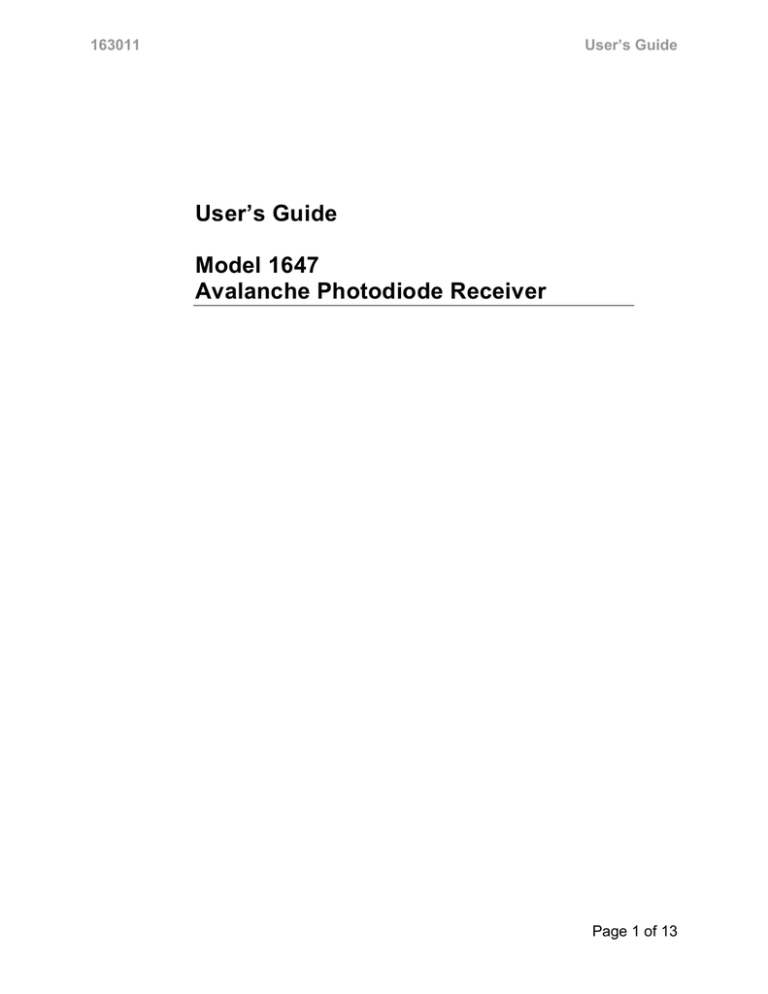
163011
User’s Guide
User’s Guide
Model 1647
Avalanche Photodiode Receiver
Page 1 of 13
New Focus Model 1647
User’s Guide
Copyright 2007 New Focus Division of Bookham. All rights reserved. New Focus and
all other New Focus product names are trademarks or registered trademarks in the
U.S.A. or other countries. All other trademarks mentioned herein are the property of
their respective companies. Products described in this catalog may be covered by one
or more patents in the U.S.A. and in other countries. Information in this catalog is
subject to change without notice.
New Focus Division of Bookham
2584 Junction Avenue
San Jose, California
USA
Tel. 408-919-1500
www.NewFocus.com
Doc. Num. 163011
Rev. 10
Page 2 of 13
163011
User’s Guide
ESD Sensitivity
The 1647 APD Receiver is sensitive to electrostatic discharge and could be
permanently damaged if subjected even to small discharges. Ground yourself
adequately prior to handling this receiver or making connections. A ground strap
provides the most effective grounding and minimizes the likelihood of
electrostatic discharge.
Avalanche Photodiode Damage Threshold
Overexposure to optical power can result in permanent damage that can result in
pulse distortion, loss of bandwidth, loss of gain, or even catastrophic failure of the
APD. The 1647 APD Receiver is more sensitive to input overpower at high bias
voltage settings; the 1647 is more tolerant to input overpower at low bias voltage
settings. The 1647 APD Receiver can withstand approximately 200 microwatts
of optical input power at bias setting = 7. The maximum power levels for other
bias settings are shown in the “Typical Parameters” table on page 6.
Before connecting the photoreceiver, measure the power in the fiber to ensure it
is within the safe operating range.
When beginning an experiment, start with the 1647 bias control knob set to
position “1”. Slowly turn up the bias voltage to the desired gain while watching
the “Saturation/Overload” Indicator on the front of the unit. If the saturation
indicator turns from GREEN to AMBER, you may want to stop increasing the bias
voltage. See “Front Panel” section of this guide for more information.
After checking the power in the fiber, connect the fiber-optic cable to the fiberoptic input of the 1647.
Page 3 of 13
New Focus Model 1647
User’s Guide
External Wiring Diagrams
OPTICAL
SOURCE
OPTICAL FIBER
OR
FREE SPACE
50 OHM
TERMINATOR
OPTICAL INPUT
- OUTPUT
1647 APD
RECEIVER
DC
VOLT
METER
COAX CABLE
+ OUTPUT
BIAS MONITOR
OUTPUT
POWER INPUT
50 OHM
COAX
CABLE
50 OHM
INPUT
OSCILLOSCOPE
NEW FOCUS MODEL 0923
PICO DOUBLE-ENDED
CORDSET MALE-MALE
NEW FOCUS
0901 POWER
SUPPLY
+/- 15VDC
Single-Ended Output Wiring Diagram
OPTICAL
SOURCE
OPTICAL FIBER
OR
FREE SPACE
OPTICAL INPUT
- OUTPUT
1647 APD
RECEIVER
DC
VOLT
METER
COAX CABLE
+ OUTPUT
BIAS MONITOR
OUTPUT
POWER INPUT
50 OHM
COAX
CABLE
50 OHM
COAX
CABLE
50 OHM INPUTS,
DIFFERENTIAL
OSCILLOSCOPE
NEW FOCUS MODEL 0923
PICO DOUBLE-ENDED
CORDSET MALE-MALE
NEW FOCUS
0901 POWER
SUPPLY
+/- 15VDC
Differential Output Wiring Diagram
Page 4 of 13
163011
User’s Guide
1647 Simplified Block Diagram
8
7
9
0
1
BIAS
KNOB
6
5
4
2
BIAS
VOLTAGE
AMPLIFIER
3
LED
X
TEMPERATURE
COMPENSATION
CIRCUIT
SATURATION
THRESHOLD
DETECT
DC
CURRENT
MONITOR
APD BIAS
CURRENT
MONITOR
OUT
APD
50
AMP
50
OUT+
OUT-
AC-Coupled Input
The 1647’s avalanche photodiode is AC-coupled to the amplifier; CW signals are
blocked. This allows for modulation measurements on a CW signal. There is no
“DC saturation” but there could be a slight decrease in effective DC bias voltage
across the APD at very high CW power levels. This means that the overall gain
of the 1647 will be decreased slightly because of the decreased effective DC bias
voltage across the APD.
Power Supply
The 1647 APD Receiver will operate with a low noise power supply such as the
New Focus Model 0901. The power enters the 1647 via three power pins:
+Power, -Power, and Common.
When using the New Focus Model 0901 Power Supply, use only the 0.3A
outputs and the Model 0923 Pico (m8) Double-Ended Male-Male Cordset. Do
not use the 3-Banana Connector, 0.1A outputs because the Model 0901 banana
jack outputs will automatically current limit and turn off.
Page 5 of 13
New Focus Model 1647
User’s Guide
Warm-Up Time
Wait one hour for the 1647 to warm up before making measurements. The
aluminum chassis will become warm. After one hour, the circuitry will thermally
stabilize for consistent measurements.
Front Panel
1) Clear Fault Button: Tests amber LED.
2) PWR Indicator: The power indicator will be GREEN when the
positive/negative input power is equal to or greater than +/-12VDC.
3) Saturation/Overload Indicator: The saturation indicator will be GREEN
during linear operation. The color will change to AMBER near the optical
power level at which the internal transimpedance amplifier begins to limit it’s
output. It is safe to operate the 1647 when the transimpedance amplifier is in
this limited condition, however the electrical output will no longer be a linear
representation of the optical input. If the input damage threshold is exceeded,
the APD could be permanently damaged. (See the “Typical Parameters” table
on page 6.)
4) Bias Monitor Connector: The bias monitor output connector is a female
SMA type. It’s output is proportional to the APD bias current and is typically
between 0 and 8.0VDC. The absolute maximum output is 9.5VDC.
5) Optical Input Connector: The optical input is via a FC/PC connector. The
light is coupled to the APD internally via a flat-polished, 10 centimeter,
62.5um core diameter multimode fiber.
Page 6 of 13
163011
User’s Guide
6) Bias Knob: The APD bias voltage control knob has ten positions for
controlling the bias voltage of the avalanche photodiode.
Typical Parameters at 1550 nm
Bias
Control
Switch
Position
APD
Bias,
Volts
Gain,
V/W
NEP,
pW/rtHz
Average
Saturation
Power, uW
BW,
GHz
Rise/Fall
Time, pS
Normalized
Pulse
Response
Optical
Overpower
Limit,
uW
1
25.5
-
-
80
-
-
APD almost
OFF
1500
2
36
3,000
5.3
28
1.4
200
800
3
49
6,000
2.7
15
1.4
210
460
4
51
7,000
2.4
13
1.3
215
400
5
53
9,000
2.0
10
1.3
220
310
6
54.5
11,000
1.8
8
1.2
230
250
7
56
14,000
1.6
6
1.1
250
200
8
58.5
30,000
1.3
3
0.6
470
80
9
59.5
50,000
1.1
2
0.2
-
45
10
60
-
-
-
-
-
APD
saturated and
very noisy
20
Page 7 of 13
New Focus Model 1647
User’s Guide
Rear Panel
1) Left SMA connector: The male SMA connector on the left is the positivegoing (+) output channel. DC signals are blocked by an internal capacitor.
Output impedance is 50 ohms.
2) Right SMA connector: The male SMA connector on the right is the
negative-going (-) output channel. DC signals are blocked by an internal
capacitor. Output impedance is 50 ohms.
The left and right SMA connectors, used together, allow for differential output
connections.
Differential outputs of 1647.
When either of the left or the right SMA connectors is not being used, it must be
terminated in 50 ohms to avoid excessive ringing on the active output. For your
convenience, a 50 ohm terminating cap is attached to the rear cover of the 1647
for this purpose.
1647 pulse response at positive output with negative output terminated (left) and unterminated
(right).
Page 8 of 13
163011
User’s Guide
Temperature Compensation
There is a temperature compensation circuit within the 1647 Avalanche Receiver.
It senses the temperature at the avalanche photodiode and adjusts the bias
voltage to maintain constant gain over a 15°C to 35°C ambient temperature
range.
Responsivity
Responsivity (normalized)
1647 Typical Responsivity
1.0
0.9
0.8
0.7
0.6
0.5
0.4
0.3
0.2
0.1
0.0
800
900
1000
1100
1200
1300
1400
1500
1600
1700
Wavelength (nm)
Page 9 of 13
New Focus Model 1647
User’s Guide
Performance Specifications
The characteristics of the APD vary according to the bias voltage setting. The
typical specifications below are given at bias voltage setting “7”.
Wavelength Range
800-1650nm
3-dB Bandwidth
15kHz – 1.1Ghz
Rise Time
250 pS
Peak Conversion Gain, single output
14,000 V/W
Peak Conversion Gain, differential outputs
28,000 V/W
Output Impedance, each output
50 Ω
NEP, single output
1.6 pW/√Hz
APD Excess Noise Factor
5
Optical Saturation Power, AC
6 uW
Optical Saturation Power, DC (CW)
200 uW
Optical Damage Threshold
200 uW average
Bias Monitor Output Bandwidth
16kHz
Page 10 of 13
163011
User’s Guide
Power & Environmental Specifications
Power Input, positive
+12 to +15VDC, 0.2A
Power Input, negative
-12 to -15VDC, 0.005A
Temperature, storage
-20°C to 60°C
Temperature, operating
-10°C to 35°C
Peak Conversion Gain Drift
10% (15°C to 35°C)
Humidity
0% to 90% RH, non condensing
Altitude
2000 m
Pollution Degree
Pollution Degree 2
Weight
200 grams
Cooling Method
Natural air circulation
Page 11 of 13
New Focus Model 1647
User’s Guide
Mechanical
Optical Input
FC, 62.5 um
Electrical Outputs
SMA, male
1647 Front View
Page 12 of 13
163011
User’s Guide
1647 Side View
1647 Rear View
Page 13 of 13


